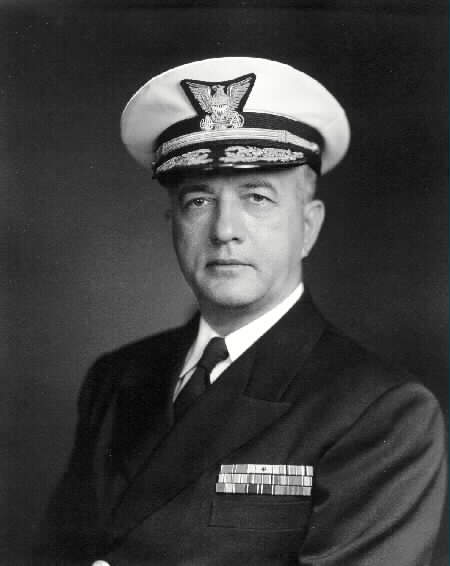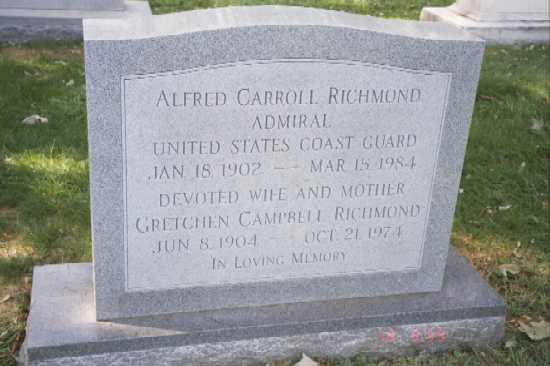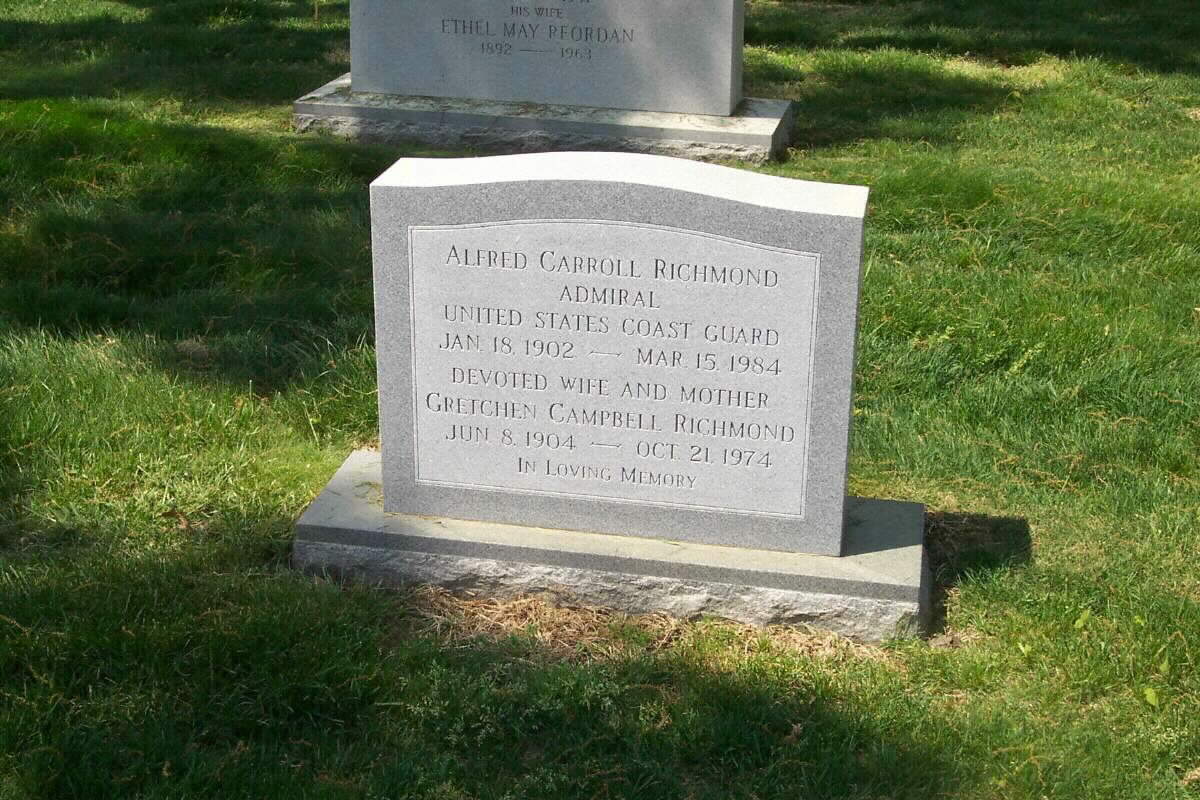Alfred Carroll Richmond, 82, the commandant of the US Coast Guard from 1954 until he retired in 1962, died of cancer March 15, 1984 at the Pilgrim Place Health Services Center in Claremont, California.
Admiral Richmond was born in Waterloo, Iowa, and reared in Arlington, Virginia. He attended George Washington University and graduated in 1924 from the US Coast Guard Academy at New London, Connecticut. His assignments before World War II included several tours of duty in Washington and service aboard a cutter in the Arctic Ocean and the Bering Sea.
During the war, he commanded a Coast Guard cutter on convoy duty in the northern Pacific and later was transferred to London. He was the senior Coast Guard officer on the staff of the commander of US Naval Forces in Europe and helped plan the invasion of Normandy. After the war, he was stationed in Washington. He was named assistant commandant of the service in 1950 and commandant four years later.
He represented the United States at a number of conferences on maritime affairs, including the first assembly of what is now the International Maritime Organization, the Safety of Life at Sea Convention in London in 1960 and the 1962 Conference on the Prevention of Pollution of the Seas. In 1960, he was president of the 6th International Lighthouse Conference.
After retiring, Admiral Richmond moved to Claremont, where he was a civil defense official for several years. His military decorations included two Distinguished Service Medals and the Bronze Star.
His first wife, Gretchen, died in 1974. Survivors include his wife, Eunice, of Claremont; two sons by his first marriage, John, of Claremont, and Marine Corps Lieutenant Colonel Alfred C. Richmond, Jr., of Arlington, and six grandchildren. He was buried in Section 11 of Arlington national Cemetery with full military honors.
His first wife, Gretchen, is buried with him.
Courtesy of the United States Coast Guard
Alfred Carroll Richmond was born in Waterloo, IA on 18 January 1902. At the age of 10, he moved with his family to Cherrydale, VA. After receiving a certificate from the Massanutten Academy of Woodstock, VA he entered George Washington University’s College of Engineering in Washington, DC at the age of 16. At the same time he was employed at the US Naval Observatory.
Appointed a cadet at the US Coast Guard Academy, New London, CT in July 1922, he was graduated senior man in his class and commissioned an Ensign on 1 October 1924. Subsequently, he advanced in rank to LTJG on 1 October 1926; LT on 1 October 1928; LCDR on 16 October 1932; CDR on 17 July l942; CAPT on 1 June 1943, Rear Admiral (when he took oath of office as Assistant Commandant) on 10 March l95O; Vice Admiral and Commandant on 1 June l954; Admiral on 1 June 1960. He retired on 1 June 1962.
From November 1924 to September 1926, he served as aide to the Commandant of the Coast Guard at Headquarters in Washington, DC. During this time he also performed temporary duty from May 1925 to July l925 as an aide to the commanding officer of the Special Patrol Force operating against “rumrunners” off the coast of New York and of the Special Service Squadron off the coast of Massachusetts. He was commended for his efficient work in this capacity.
Beginning in September 1926, he was assigned for two years as a member of the Coast Guard Academy staff. During this period he served temporarily with the Cutter Mojave from June to September 1927. He took part in the cadet practice cruise aboard the Destroyer Shaw during the Summer of 1928. In October 1928 he was assigned a course of instructions at the Sperry Gyro Compass School at Brooklyn, NY, after which he
became navigator aboard the Cutter Pontchartrain stationed at Quincy, MA. From July to November 1930, he served as executive officer of the Destroyer Wainwright in the Gulf Division.
He then reported to the Coast Guard representative at the Philadelphia Navy Yard. He was assigned as executive officer of the Destroyer Herndon, Flagship of Division III, Destroyer Force, when the ship was commissioned and assigned to Boston for permanent station.
In May 1932 he transferred to Coast Guard Headquarters to undertake duties in connection with the small arms training of a Coast Guard Detachment which he helped assemble at Camp Curtis Guild, Wakefield, MA. He then accompanied this detachment to such places as Cascade, MD and Quantico, VA for the National Rifle Association regional shooting matches and the national matches held at Ft. Sheridan, IL. Completing this tour in August, he returned to Headquarters and two months later became executive officer of the Cutter Haida stationed at Cordova, AK. From this base the cutter performed patrol duty in the Bering Sea and Arctic waters.
In September l935 he again was assigned to Coast Guard Headquarters. He began taking a resident law course at the George Washington University. He was graduated on June 8, 1938, and awarded a degree of Juris Doctor “with distinction.” Thereupon, he was assigned duties in Headquarters’ Office of Operations. His collateral duties included assisting in the preparation of certain law enforcement education material and assisting the Engineer-in-Chief in the preparation of permanent land records for property held by the government for Coast Guard use. He served also as a representative of the Treasury Department and the United States at the International Whaling Conference convened at
London, England on 17 July 1939.
A transfer in May 1941 sent him to the Bethlehem Steel Co. at Baltimore, MD. His duties were connected to outfitting of the new Coast Guard vessel American Sailor. This vessel was intended for training maritime personnel, the responsibility of the Coast Guard at that time. After placing the ship into commission, he commanded it from her assigned station at Port Hueneme CA. He also commanded the Maritime Service
Training Station (assuming charge in February 1942).
From September 1942 (when the American Sailor and the Maritime Service were transferred to the War Shipping Administration) until February l943, he served as commanding officer of the Cutter Haida. Stationed at Juneau AK, the cutter’s primary mission was convoy escort duty. He was then assigned to the Merchant Marine Inspection Office of the Third Coast Guard District in New York City. His duties there included those of examining officer and hearing officer.
Transferred overseas in July 1943, he became Senior Coast Guard Officer in charge of the US Coast Guard Merchant Marine Hearing Unit in London, England. His duties there included administering and enforcing the laws and regulations related to the functions of the Coast Guard vessels and personnel involved with the U.S. Naval Forces in Europe. This also included being the examining and hearing officer administering laws and regulations governing investigations of accidents and casualties involving United States vessels and personnel.
Later, he received the Bronze Star “for meritorious service as Senior Coast Guard Officer on the Staff of the Commander, United States Naval Forces in Europe” during and after the Normandy invasion. He assisted in organizing Coast Guard Forces preparing for the invasion and contributed to the efficiency of the merchant marine ships sailing the invasion routes. Meanwhile the French Governrnent awarded him the Croix de Guerre “for exceptional services” rendered in the liberation of France.
In May 1945 he was assigned to duty at USCG Headquarters. He was originally billeted as Chief, Supply Division. The following month, however, he was designated Chief, Program Planning Division. In August, he again changed his assignment becoming Chief, Budgets and Requirements and Assistant Chief, Planning and Control.
On 9 March 1950, with the advice of the President and consent of the Senate, he was appointed Assistant Commandant of the Coast Guard with the rank of Rear Admiral for a four-year term. Effective 1 May 1951, with a reorganization of the Coast Guard, he assumed the additional duties of Chief of Staff. He was appointed Commandant of the Coast Guard with the rank of Vice Admiral on 13 May 1954, to succeed Vice Admiral
Merlin O’Neill upon his retirement. Richmond took his oath of office on 1 June 1954. On 22 April l958, the Senate confirmed a second four-year term for Admiral Richmond as Commandant, effective on1June 1958.
Effective 1June 1960, Richmond was appointed to the rank of full Admiral by the President with confirmation from the Senate. This was possible under the authority provided by Act of 14 May 1960, Public Law 86-474, which pertains to a reorganization of top commands. This act amended Title 14, US Code Section 41and 44 (only two previous Commandants had attained the rank of Admiral while in office, all subsequent
Commandants have been Admirals).
He was active in international affairs, particularly in maritime issues. In January 1959 he was a principal delegate to the First Assembly of the Intergovernmental Maritime Consultative Organization (IMCO). He also represented the United States on four other occasions as head of the US delegation to the Maritime Safety Committee of IMCO. He also headed the US delegation to the Safety of Life at Sea Convention in London
in 1960. For this service he was presented the Distinguished Service Medal. In 1961 he was delegate to the Second Assembly meeting of IMCO. Admiral Richmond also served as president of the 1960 Sixth International Lighthouse Conference and president of the Executive Committee of the International Association of Lighthouse Authorities. He was also chairman of the National Committee for Prevention of Pollution of Seas by
oil and headed the United States delegation to the 1962 conference.
Admiral Richmond turned over his official duties as Commandant of the US Coast Guard to his successor, Admiral Edwin J. Roland in formal change-of-command ceremonies held aboard the Coast Guard Cutter Campbell on 31 May. The next day, 1 June 1962, he retired effective immediately. For “exceptionally meritorious service” performed as Commandant from 1 June 1954 to 31 May 1962, Admiral Richmond received the Gold Star in lieu of a Second Distinguished Service Medal.


Michael Robert Patterson was born in Arlington and is the son of a former officer of the US Army. So it was no wonder that sooner or later his interests drew him to American history and especially to American military history. Many of his articles can be found on renowned portals like the New York Times, Washingtonpost or Wikipedia.
Reviewed by: Michael Howard

